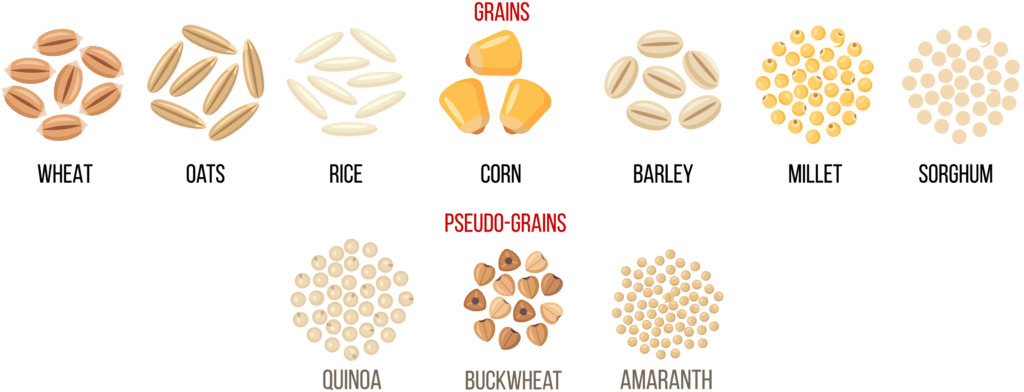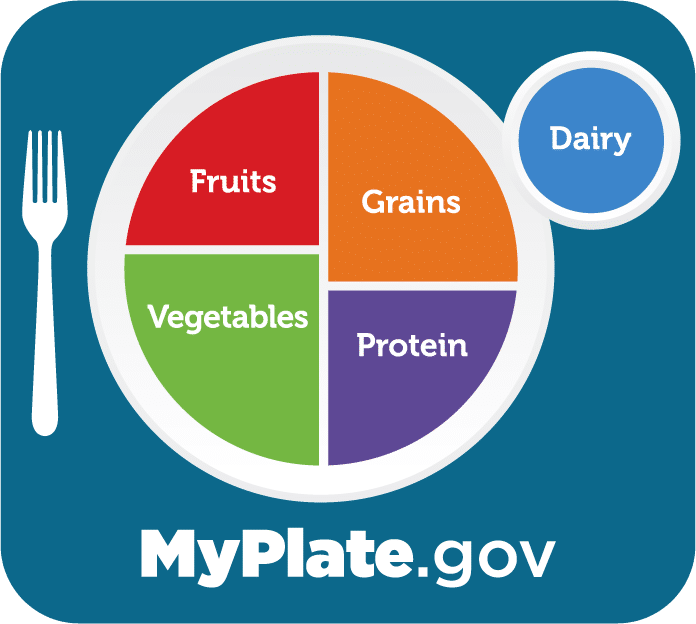They’re naturally satisfying and always nourishing. Learn what a grain is and how they can help meet your health goals.
What are grains? They’re the edible seeds of certain grasses, and they range widely in origin, flavor and texture. Wheat, oats, rice and corn are common grain foods, while barley, spelt, millet and sorghum are less common but just as delicious and nutritious. Pseudo grains are foods that are not true grains but may be similar in appearance and nutrition to true grains – like quinoa, buckwheat and amaranth.

| What’s a Serving? A serving of grain foods is about one ounce. This equates to a slice of bread, a cup of cereal or ½ cup of uncooked rice or pasta. The number of servings you may need each day depends on several factors such as age, weight, gender and activity level. Check out MyPlate’s chart to find out what counts as a serving of different grain foods. |
Grain foods are one of the major food groups in a healthy eating pattern. They provide critical nutrition:
- Dietary fiber
- Essential vitamins such as folate, thiamin, niacin, vitamin B6, riboflavin and vitamin A
- Minerals such as iron, zinc, manganese, copper, magnesium, phosphorus and selenium
This is important because the vast majority of Americans – 95% of us, in fact – don’t get enough fiber in our diets. Additionally, most Americans don’t meet the recommended intake of several nutrients – identified as “nutrients of concern” by the U.S. Dietary Guidelines. The Grains group is a substantial contributor of many of these nutrients for the general population (fiber: 37-44%; calcium: 12-21%), as well as populations with special nutrient needs (folate: 55-64%; iron: 56-62%). As such, most people would benefit from increasing the proportion of grain foods in their diet.
If this surprises you, consider this: grain foods account for just 15% of calories in an average American’s diet and this number is similar across all ethnicities. So, grains actually offer a greater proportion of some nutrients than calories!
MyPlate, which is the tool developed by the U.S. Department of Agriculture (USDA) to help Americans make healthful choices, allots about one-quarter of a standard plate for grain foods, approximately the same amount as proteins, fruits and vegetables. This means when you’re serving up a meal for yourself or others, grain foods should cover about a quarter of the plate.

Whole Grains and Refined Grains
Based on an assessment of the latest published scientific research, the Dietary Guidelines advise Americans to make at least half their grains come from whole grain sources, and the guidelines also make clear the importance of choosing enriched, refined grains as the other half of their grain servings.
Whole grains include all three parts of a grain: the outer bran, the endosperm, and the germ, which is like the heart of the grain. You can eat whole grains intact – an example is whole grain basmati rice – or ground into flour and prepared in foods, such as whole wheat flour or whole cornmeal. Whole grains contain all the nutrients found in the grain kernel, including fiber and B vitamins.
Refined grains, on the other hand, contain only the endosperm, the starchy part that makes up about 80% of a grain. This part of the grain is a concentrated source of carbohydrates and protein, as well as some vitamins and minerals.

The Importance of Enriched Grains
Many refined grains are enriched, which means they have vitamins and minerals added after the milling process. Thiamin, riboflavin, niacin, folic acid and iron are all common additions. In fact, in 1998 the Food and Drug Administration (FDA) began requiring all enriched wheat products to be fortified with folic acid as a way to prevent neural tube defects during early pregnancy.
Refined, enriched grain foods are incredibly important in Americans’ diets. For example, a study analyzing food intake data shows that Americans get more folic acid from grain foods than from vegetables. Another study showed that a variety of grain foods, including enriched grains, contribute to helping children meet their nutrient needs. The folic acid fortification requirement for wheat products has been one of the most successful fortification programs to date, responsible for a 35% reduction in neural tube defects since its inception.
Eating just whole grains, and no refined grains, would have negative, unintended consequences on Americans’ diets. A modeling study found that if only whole grains were required in the diet, with enriched grains or other substitutions not allowed, people would be at risk for nutritional deficiency.
All in all, a healthy eating pattern should include a mix of whole and refined grains. If you love fortified white bread for sandwiches, for example, that’s OK! Just work whole grains, such as oats, polenta or whole wheat pasta, into your meals at other times of day.

